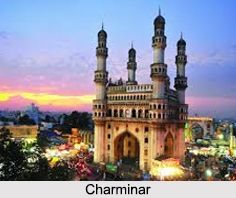 Built in 1591 under the reign of Muhammad Quli Qutb Shah, the fifth ruler of the Qutb Shahi dynasty, Charminar or the four minarets is a monument and mosque in the city of Hyderabad in the state of Telangana. The monument was built after Qutb Shah shifted his capital from Golconda to the newly formed city of Hyderabad.
Built in 1591 under the reign of Muhammad Quli Qutb Shah, the fifth ruler of the Qutb Shahi dynasty, Charminar or the four minarets is a monument and mosque in the city of Hyderabad in the state of Telangana. The monument was built after Qutb Shah shifted his capital from Golconda to the newly formed city of Hyderabad.
There are various theories and records regarding the purpose of the construction of Charminar. Some of which suggest that the monument was established to commemorate the eradication of the deadly plague, cholera. It is said that the sultan had prayed for the end of the plague that was ravaging his city and vowed to build a mosque at the very place where he prayed. Other theories suggest that Charminar was built to mark the beginning of the second Islamic millennium year.
The 4 towering and distinctive minarets of the Charminar on each of the building"s 4 corners formed the centrepiece around which the city of Hyderabad was planned. The monument is an architectural marvel of the Indo - Islamic architectural style, incorporating elements from Persian architecture. More than 4 centuries old, the marvellous structure of Charminar is known as the Arc de Triomphe of the east.
It was known that the sultan, Qutb Shah was among the early poets of Dakhani Urdu and while laying down the foundation of the monument, he had performed the prayers in Dakhini couplets, the translated verses of which are recorded as follows:
"Fill this city of mine with people as,
You filled the river with fishes O Lord."
The history of Charminar is truly interesting, the monuments has been through the trials of time but has been re-plastered and repaired each time and now stands as an archaeological and architectural treasure on the official "List of Monuments" prepared by the Archaeological Survey of India.
This article is a stub. You can enrich by adding more information to it. Send your Write Up to [email protected]



















